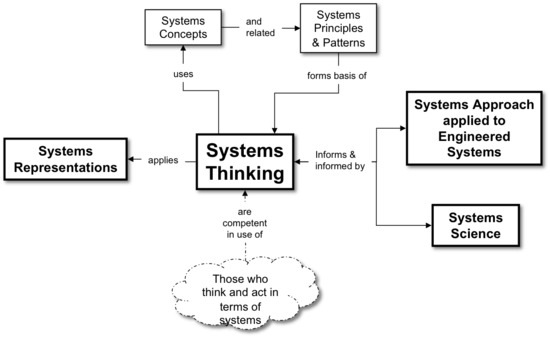Difference between revisions of "Systems Thinking"
| Line 15: | Line 15: | ||
[[Systems Thinking (glossary)]] is concerned with understanding or intervening in problem situations, based on the principles and concepts of the systems paradigm. This KA offers some basic definitions of systems thinking. The following diagram summarizes how the knowledge is presented. | [[Systems Thinking (glossary)]] is concerned with understanding or intervening in problem situations, based on the principles and concepts of the systems paradigm. This KA offers some basic definitions of systems thinking. The following diagram summarizes how the knowledge is presented. | ||
| − | [[File:Fig2_Systems_Thinking_and_Systems_Science_RA.png| | + | [[File:Fig2_Systems_Thinking_and_Systems_Science_RA.png|550px|thumb|center|'''Figure 1. Systems Thinking and Systems Science.''' (SEBoK Original)]] |
Systems Thinking considers the similarities between systems from different domains in terms of a set of common Systems Concepts, Principles and Patterns. | Systems Thinking considers the similarities between systems from different domains in terms of a set of common Systems Concepts, Principles and Patterns. | ||
Revision as of 20:23, 13 August 2012
This Knowledge Area (KA) provides a guide to knowledge about systems thinking which is the integrating paradigm for systems science and Systems Approaches to practice.
This is part of the wider systems knowledge which can help to provide a common language and intellectual foundation; and make practical systems concepts, principles, patterns and tools accessible to systems engineering as discussed in the Introduction to Part 2.
To download a PDF of all of Part 2 (including this knowledge area), please click here.
Topics
The topics contained within this knowledge area include the following:
- What is Systems Thinking?
- Concepts of Systems Thinking
- Principles of Systems Thinking
- Patterns of Systems Thinking
Introduction
systems thinking is concerned with understanding or intervening in problem situations, based on the principles and concepts of the systems paradigm. This KA offers some basic definitions of systems thinking. The following diagram summarizes how the knowledge is presented.
Systems Thinking considers the similarities between systems from different domains in terms of a set of common Systems Concepts, Principles and Patterns.
- A principle is a rule of conduct or behavior. To take this further, a principle is a “basic generalization that is accepted as true and that can be used as a basis for reasoning or conduct” (WordWeb.com).
- A concept is an abstraction, or a general idea inferred or derived from specific instances.
Principles depend on concepts in order to state a “truth.” Hence, principles and concepts go hand in hand; principles cannot exist without concepts and concepts are not very useful without principles to help guide the proper way to act (Lawson and Martin 2008).
Many sources combine both concepts and the principles based on them. The Concepts article presents concepts extracted from a variety of theory and practice sources. A summary of important Principles referring back to the concepts upon which they are based is also provided.
A pattern is an expression of observable similarities found in systems from different domains. Patterns exist in both natural and man-made systems, and are used in systems science and systems engineering. A summary of the different classes of patterns and the use of patterns to support a Systems Approach is discussed in the final article of this KA.
The practical application of Systems Thinking is often through the use of abstract System Representations or models. Some mention of these models is made in the KA, and a more complete guide provided in Representing Systems with Models.
References
Works Cited
Lawson, H., and J.N. Martin. 2008. "On the Use of Concepts and Principles for Improving Systems Engineering Practice". Proceedings of the 18th Annual International Council on Systems Engineering (INCOSE) International Symposium, 5-19 June 2008, Utrecht, The Netherlands.
Primary References
Bertalanffy, L. von. 1968. General System Theory: Foundations, Development, Applications. Revised ed. New York, NY: Braziller.
Checkland, P. 1999. Systems Thinking, Systems Practice, New York, NY, USA: John Wiley & Sons.
Churchman, C. W. 1968. The Systems Approach and its Enemies. New York, NY, USA: Dell Publishing.
Flood, R. L. 1999. Rethinking the Fifth Discipline: Learning Within The Unknowable. London UK: Routledge.
INCOSE. 2011. INCOSE Systems Engineering Handbook: A Guide for System Life Cycle Processes and Activities, version 3.2.1. San Diego, CA, USA: International Council on Systems Engineering (INCOSE), INCOSE-TP-2003-002-03.2.1.
Additional References
Ackoff, R.L. 1971. "Towards a System of Systems Concepts". Management Science. 17(11).
Hitchins, D. 2009. "What Are the General Principles Applicable to Systems?" Insight 12(4).
Lawson, H. 2010. A Journey Through the Systems Landscape. London, UK: College Publications, Kings College.
SEBoK Discussion
Please provide your comments and feedback on the SEBoK below. You will need to log in to DISQUS using an existing account (e.g. Yahoo, Google, Facebook, Twitter, etc.) or create a DISQUS account. Simply type your comment in the text field below and DISQUS will guide you through the login or registration steps. Feedback will be archived and used for future updates to the SEBoK. If you provided a comment that is no longer listed, that comment has been adjudicated. You can view adjudication for comments submitted prior to SEBoK v. 1.0 at SEBoK Review and Adjudication. Later comments are addressed and changes are summarized in the Letter from the Editor and Acknowledgements and Release History.
If you would like to provide edits on this article, recommend new content, or make comments on the SEBoK as a whole, please see the SEBoK Sandbox.
blog comments powered by Disqus